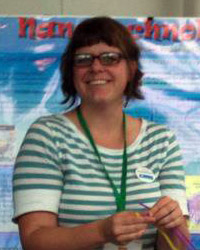Happy birthday on the 9th, 10th, and 11th of December to Grace Hopper, Ada Lovelace, and Annie Jump Cannon, respectively!
Grace Hopper: Born December 9, 1906 in New York City, Grace Hopper was said to always be curious. At the age of seven, after deciding to figure out how alarm clocks worked, she systematically dismantled seven alarm clocks in her house before her mother caught on. She graduated from Vassar College in 1928 with degrees in mathematics and physics before gaining her Ph. D. in mathematics from Yale in 1930. She taught mathematics at Vassar College until 1943, when she joined the US Navy Reserve WAVES program. Assigned to the Bureau of Ships Computation Project in 1944 under Howard Aiken, she would co-author three papers on the developing Mark I computer over the next 5 years. In 1949, she began working on the UNIVAC I. During this project she also produced one of the first working compiler, the A compiler, in 1952. Although initially no one believed her, by 1954 she was appointed the first director of automatic programming.
In 1959, Hopper became the technical assistant in charge of developing the COBOL programming language, one of the first to use English-based code and be machine-independent. COBOL is still in use today. During the 70s, Hopper pushed for the creation of standards to test computer systems, components, and programming languages. These Navy standards led to significant convergence of programming languages used in computers and in the 80s were officially acquired by the National Bureau of Standards, now the National Institute of Standards and Technology. By her retirement in 1966, Hopper had been promoted to a Naval Reserve Commander, eventually achieving the rank of commodore by special Presidential Appointment. Over her life, she was made to retire from the Naval Reserve three times, although that never stopped her from continuing her work. Perhaps the best accomplishment of Rear Admiral Hopper, even according to her, was her commitment to training young people. Grace Hopper died in 1992.
Ada Lovelace: Born on December 10, 1815 as Augusta Ada Byron, she was the only legitimate child of Lord Byron. Byron separated from his family soon after Ada was born. Her mother, Anne Byron (who by some accounts was also an intelligent mathematician) encouraged her daughter to study mathematics and logic in part to curb the insane romaticism she worried Ada had inherited from her father. This talent for mathematics led her to a friendship with Charles Babbage, and their working relationship led to Ada Lovelace collaborating on Babbage’s Analytical Engine. In 1842 and 1843, her work with Luigi Menabrea’s article on analytical engines culminated in what many consider the first computer program. While Babbage focused on the number-crunching capabilities of his engine, Ada Lovelace suggested that these machines could go much further into other fields of science. Ada Lovelace died at age 36 from uterine cancer. Possibly more so than any other scientist discussed thus far, I encourage everyone to read more about Lovelace’s work, and the controversy that still surrounds her contributions to science. Or, for something lighter, you could check out Kate Beaton’s Hark A Vagrant comic on Ada Lovelace, available online.
Annie Jump Cannon: As you may see in the Google Doodle, December 11 marks Annie Jump Cannon’s 151st birthday. Born in Dover, DE to a Delaware state senator, Cannon was taught about the stars from an early age by her mother. In 1884 she graduate from Wellesley College with physics and astronomy degrees. After two additional years studying solely astronomy at Radcliffe College, she was hired as an assistant at the Harvard Observatory in 1896. Hired to be one of “Pickering’s Women” (named after then observatory head E.C. Pickering) she work to empirically classify stars in the southern hemisphere. Her star classification system was created from two already known models into the now-universal O, B, A, F, G, K, M system. Between 1881 and 1924, Cannon classified more than 225,000 stars. In 1911, when she became curator of astronomical photographs, it was said she could classify as many as three stars a minute. In 1925, she became the first woman to receive an honorary doctorate from the University of Oxford. She was given the Henry Draper Gold Metal by the National Academy of Sciences, and was the first female officer of the American Astronomical Society. Cannon retired in 1940, and died a year later, still living in Cambridge, MA.

